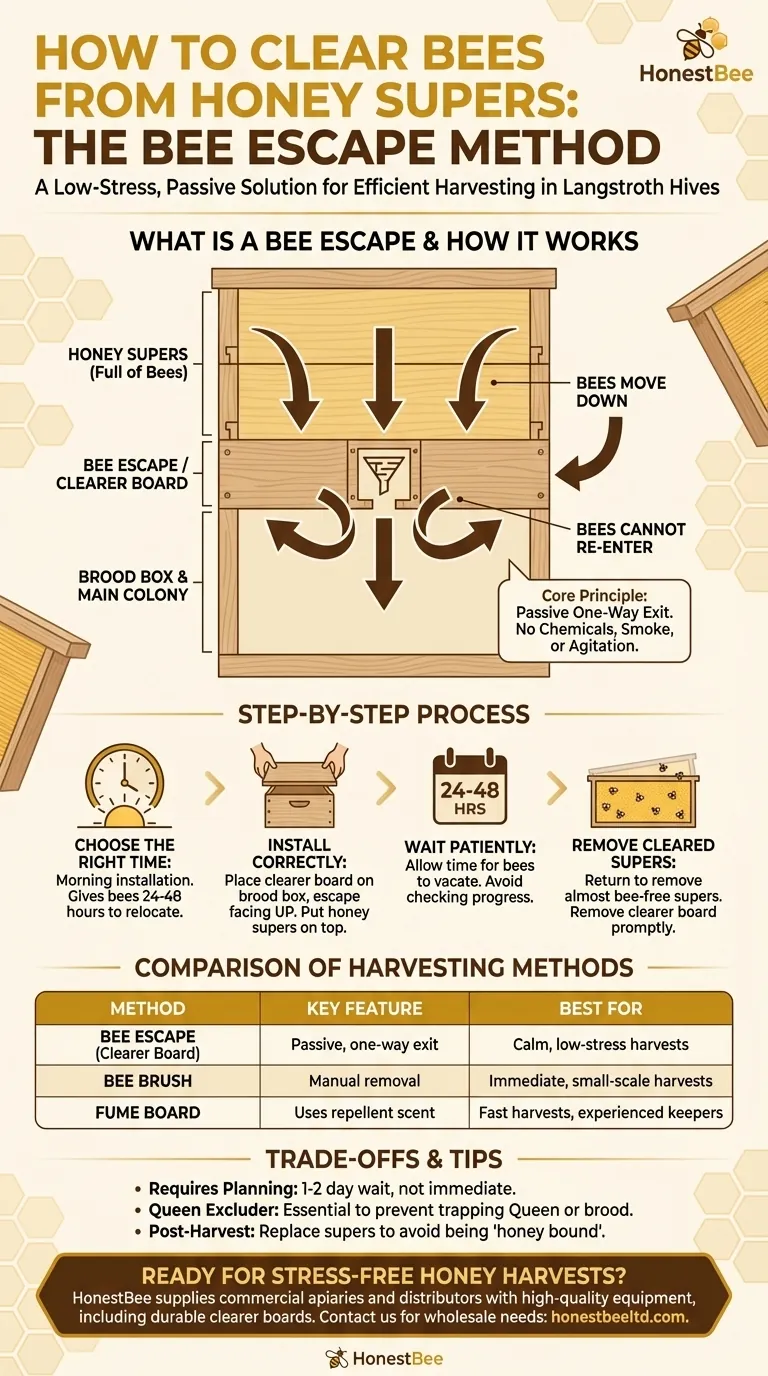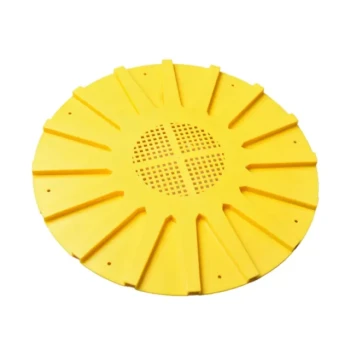To clear bees from honey supers, the most effective and low-stress method for both the beekeeper and the colony is to use a bee escape, often called a clearer board. This device is installed below the honey supers you intend to harvest, and over a period of 24 to 48 hours, it allows the bees to move down into the brood box while preventing them from re-entering the supers.
The core challenge of harvesting honey is separating the bees from the frames efficiently and calmly. A bee escape solves this by functioning as a passive, one-way exit, leveraging the bees' natural movement to clear the supers for you without chemicals, smoke, or agitation.

What is a Bee Escape and How Does it Work?
A bee escape is a simple inner cover fitted with a device that creates a one-way path. Bees can easily travel through it in one direction but find it nearly impossible to return.
The Core Principle: A One-Way Door
The escape mechanism itself is a small plastic or metal maze or funnel. Worker bees, which naturally move between the brood chamber and honey supers, can navigate down through the escape's opening into the main hive body.
However, when they try to return to the supers, they cannot find the small, precise entrance from below, effectively trapping them out of the honey storage area.
Why This Method is Preferred
Using a clearer board is widely considered the gentlest method for clearing bees. It avoids the frantic energy of using a bee brush and the potential for honey contamination or agitation associated with fume boards and chemical repellents.
This passive approach keeps the colony calm, reduces the risk of stings, and makes the process of removing heavy, honey-filled supers a much quieter and more manageable task.
The Step-by-Step Process for Using a Clearer Board
Correct installation and timing are critical for the bee escape to work effectively. Following these steps will ensure a successful clearing.
Step 1: Choose the Right Time
The best time to install the clearer board is in the morning. This gives the bees the entire day and the following night to move down into the brood chamber.
Step 2: Install the Board Correctly
Remove the honey supers you wish to harvest. Place the clearer board directly on top of the brood box (or the topmost super you are not harvesting). The opening of the escape mechanism must face upward, into the honey supers that will be placed on top of it.
Then, place the honey-filled supers you want to clear directly on top of the clearer board and replace the hive's main cover.
Step 3: Wait Patiently
Allow 24 to 48 hours for the bees to vacate the supers. The vast majority of bees will move down to be with the queen and brood during this time. Resisting the urge to check on the progress is key to letting the device work.
Step 4: Remove the Cleared Supers
After the waiting period, return to the hive—preferably in the morning when any remaining bees are less active. The supers should now be almost entirely free of bees and ready for removal.
After taking the honey supers, it is crucial to remove the clearer board. Leaving it on can block ventilation and disrupt the colony's normal movement.
Understanding the Trade-offs and Common Pitfalls
While highly effective, the bee escape method is not without its limitations. Understanding them ensures you use the tool correctly.
The Major Factor is Time
The primary trade-off is speed. This method is not for an immediate harvest; it requires planning and a one- to two-day wait. If you need to pull honey on short notice, this is not the right tool.
A Queen or Drones Can Get Trapped
If you do not use a queen excluder and the queen has laid eggs in the honey supers, she will be trapped above the clearer board. Likewise, large drones can sometimes get stuck in the escape mechanism, blocking it for other bees.
Ensure Proper Post-Harvest Management
Once you remove the full supers and the clearer board, replace them with empty frames or supers. This gives the colony space to continue their work and prevents them from becoming "honey bound," a condition where they run out of room for the queen to lay eggs.
Making the Right Choice for Your Harvest
Your goal for the harvest will determine if the clearer board is the best method for your situation.
- If your primary focus is a calm, low-stress harvest: The bee escape is the ideal tool, as it works passively without agitating the colony or the beekeeper.
- If your primary focus is preserving the colony's natural rhythm: This method is superior to brushing or blowers, as it allows bees to move at their own pace.
- If your primary focus is speed and you must harvest immediately: You will need to use a more active method like a bee brush or a bee blower, but be prepared for more disruption and defensive behavior from the hive.
By working with the bees' natural tendencies, you make the harvest a smooth and successful part of your beekeeping journey.
Summary Table:
| Method | Key Feature | Best For |
|---|---|---|
| Bee Escape (Clearer Board) | Passive, one-way exit | Calm, low-stress harvests |
| Bee Brush | Manual removal | Immediate, small-scale harvests |
| Fume Board | Uses repellent scent | Fast harvests, experienced keepers |
Ready for a stress-free honey harvest? HONESTBEE supplies commercial apiaries and beekeeping equipment distributors with the high-quality tools needed for efficient, gentle hive management. Our wholesale-focused operations ensure you get the reliable equipment—including durable clearer boards—that your business depends on. Contact our team today to discuss your wholesale needs and streamline your beekeeping operations.
Visual Guide

Related Products
- Professional Durable Two-Piece Plastic Bee Escape
- Circular Labyrinth Bee Escape for Efficient Hive Management
- HONESTBEE Multi Exit Plastic Bee Escape Board for Efficient Honey Harvesting
- Efficient Hive Clearing: HONESTBEE 8-Way Plastic Bee Escape
- High-Efficiency Diamond Maze Bee Escape for Clearing Supers
People Also Ask
- How is an escape board constructed? A Guide to Gentle, Chemical-Free Honey Harvesting
- How does a bee escape work in a beehive? Master Gentle Honey Harvesting with a One-Way Gate
- What is the purpose of a bee escape board? A Gentle, Chemical-Free Way to Harvest Honey
- How is a bee escape board used in a hive? A Simple Guide to a Calm, Chemical-Free Honey Harvest
- How does a bee escape board work? A Gentle Guide to a Stress-Free Honey Harvest



















